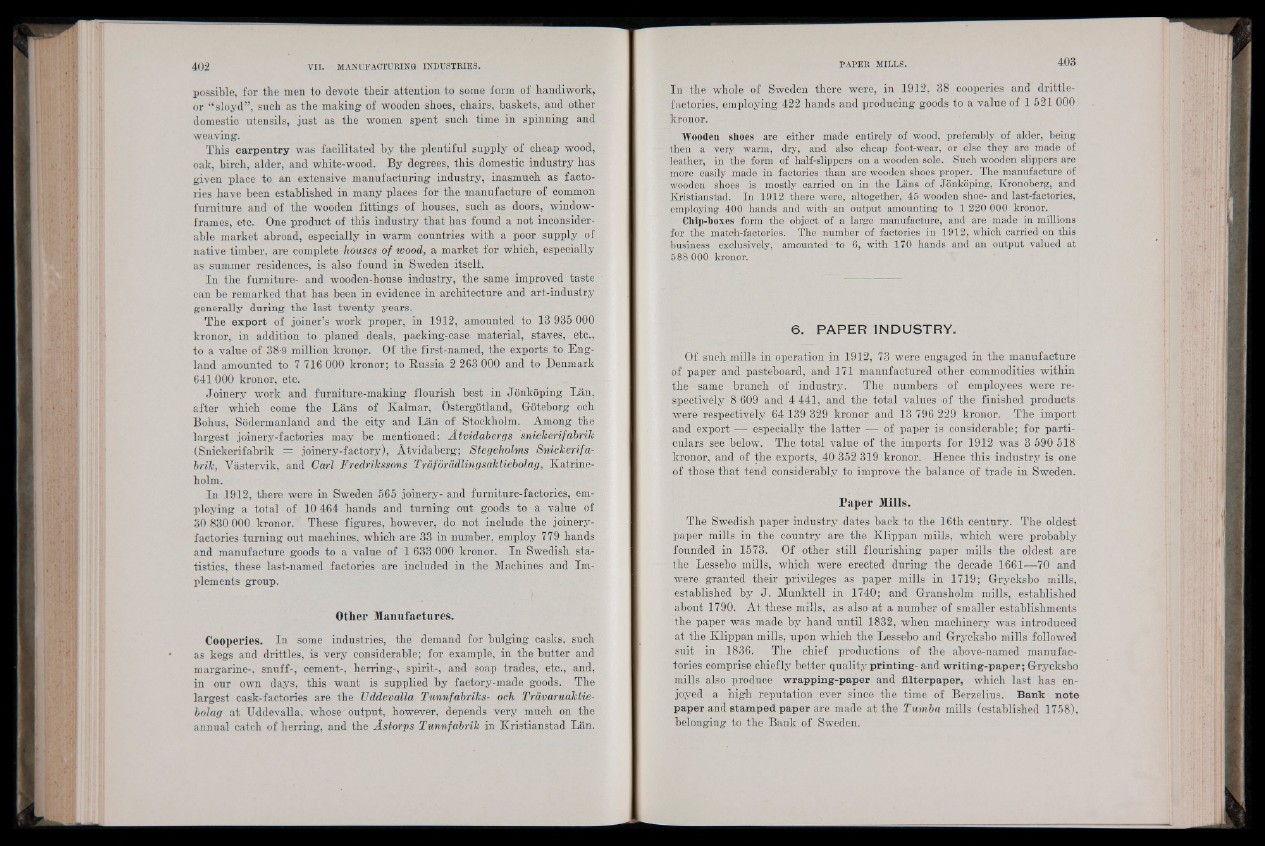
possible, for the men to devote tbeir attention to some form of handiwork,
or “ sloyd”, such as the making of wooden shoes, chairs, baskets, and other
domestic utensils, just as the women spent such time in spinning and
weaving.
This carpentry was facilitated by the plentiful supply of cheap wood,
oak, birch, alder, and white-wood. By degrees, this domestic industry has
given place to an extensive manufacturing industry, inasmuch as factories
have been established in many places for the manufacture of common
furniture and of the wooden fittings of houses, such as doors, window-
frames, etc. One product of this industry that has found a not inconsiderable
market abroad, especially in warm countries with a poor supply of
native timber, are complete houses of wood, a market for which, especially
as summer residences, is also found in Sweden itself.
In the furniture- and wooden-house industry, the same improved taste
can be remarked that has been in evidence in architecture and art-industry
generally during the last twenty years.
The export of joiner’s work proper, in 1912, amounted to 13 935 000
kronor, in addition to planed deals, packing-case material, staves, etc.,
to a value of 38-9 million kronyr. Of the first-named, the exports to England
amounted to 7 716 000 kronor; to Russia 2 263 000 and to Denmark
641 000 kronor, etc.
Joinery work and furniture-making flourish best in Jönköping Län,
after which come the Läns of Kalmar, Östergötland, Göteborg och
Bohus, Södermanland and the city and Län of Stockholm. Among the
largest joinery-factories may be mentioned: Ätvidabergs snickerifabrik
(Snickerifabrik = joinery-factory), Ätvidaberg; Stegeholms Snickerifabrik,
Vastervik, and Carl Fredrikssons Träförädlingsaktiebolag, Katrine-
holm.
In 1912, there were in Sweden 565 joinery- and furniture-factories, employing
a total of 10 464 hands and turning out goods to a value of
30 830 000 kronor. These figures, however, do not include the joinery-
factories turning out machines, which are 33 in number, employ 779 hands
and manufacture goods to a value of 1 633 000 kronor. In Swedish statistics,
these last-named factories are included in the Machines and Implements
group.
Other Manufactures.
Cooperies. In some industries, the demand for bulging casks, such
as kegs and drittles, is very considerable; for example, in the butter and
margarine-, snuff-, cement-, herring-, spirit-, and soap trades, etc., and,
in our own days, this want is supplied by factory-made goods. The
largest cask-factories are the Uddevalla Tunnfabriks- och Trävaruaktie-
bolag at Uddevalla, whose" output, however, depends very much on the
annual catch of herring, and the Ästorps Tunnfabrik in Kristianstad Län.
In the whole of Sweden there were, in 1912, 38 cooperies and drittle-
factories, employing 422 hands and producing goods to a value of 1 521 000
kronor.
Wooden shoes are either made entirely of wood, preferably of alder, being
then a very warm, dry, and also cheap foot-wear, or else they are made of
leather, in the form of half-slippers on a wooden sole. Such wooden slippers are
more easily made in factories than are wooden shoes proper. The manufacture of
wooden shoes is mostly carried on in the Lans of Jonkoping, Kronoberg, and
Kristianstad. In 1912 there were, altogether, 45 wooden shoe- and last-factories,
employing 400 hands and with an output amounting to 1 220 000 kronor.
Chip-boxes form the object of a large manufacture, and are made in millions
for the mateh-factories. The number of factories in 1912, which carried on this
business exclusively, amounted to 6, with 170 hands and an output valued at
588 000 kronor.
6 . PAPER INDUSTRY.
Of such mills in operation in 1912, 73 were engaged in the manufacture
of paper and pasteboard, and 171 manufactured other commodities within
the. - same branch of industry. The numbers of employees were respectively
8 609 and 4 441, and the total values o f the finished products
were respectively 64 139 329 kronor and 13 796 229 kronor. The import
and export — especially the latter •— of paper is considerable; for particulars
see below. The total value of the imports for 1912 was 3 590 518
kronor, and of the exports, 40 352 319 kronor. Hence this industry is one
of those that tend considerably to improve the balance of trade in Sweden.
Paper Mills.
The Swedish paper industry dates back to the 16th century. The oldest
paper mills in the country are the Klippan mills, which were probably
founded in 1573. Of other still flourishing paper mills the oldest are
the Lessebo mills, which were erected during the decade 1661*^70 and
were granted their privileges as paper mills in 1719; Grycksbo mills,
established by J. Munktell in 1740; and Gransholm mills, established
about 1790. At these mills, as also at a number of smaller establishments
the paper was made by hand until 1832, when machinery was introduced
at the Klippan mills, upon which the Lessebo and Grycksbo mills followed
suit in 1836. The chief productions of the above-named manufactories
comprise chiefly better quality printing- and writing-paper; Grycksbo
mills also produce wrapping-paper and fllterpaper, which last has enjoyed
a high reputation ever since the time of Berzelius. Bank note
paper and stamped paper are made at the Tumba mills (established 1758),
belonging to the Bank of Sweden.